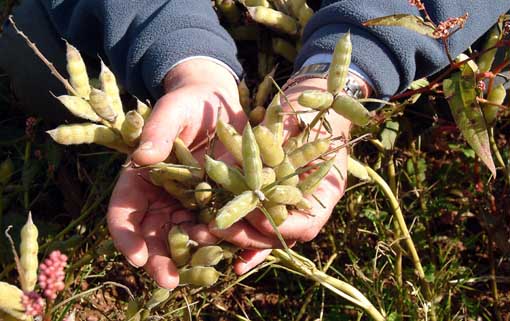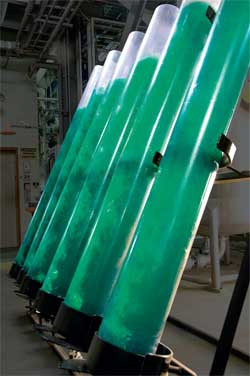Feeding ideas for the future

Market volatility and a reliance on feed imports has left the UK livestock industry hugely vulnerable to external influence.
According to David McNaughton, a director for SoyaUK, the next nine years are likely to bring increasing problems in terms of protein feed supplies.
“In recent years, we have seen an increasing gulf between soya demand and production. This has driven a price rise for soya beans from £150/t to £400/t. Over the next few years, this gulf is only going to get wider.”
The UK currently imports three million tonnes of soya and soya products every year, with 2.8 million tonnes of this going into the animal feed industry.
The question is, what can we do to make the livestock industry less reliant on imported protein, says Mr McNaughton.
NWF technical manager Tom Hough says market volatility is here to stay and as such, farmers need to think ahead and be prepared.
“Producers need to start adopting a buying policy to try to reduce volatility and think to the season ahead.”
Any decisions made in the next nine years will be to protect ourselves against rising input costs, says nutritionist Diana Allen, Quality Nutrition Management.
To help mitigate these challenges, producers should aim to grow as much on farm as possible and balance maize with lucerne, where growing conditions are suitable.
“Ideally, we need to grow more proteins such as lupins or lucerne in this country. It would be great to see more collaboration between livestock and arable farmers, but it all comes down to economics – if wheat prices continue to be high, arable producers are unlikely to experiment with alternatives for the livestock market.”
Climate change may also mean it is not out of the question to think soya might be grown in Northern Europe or Kent by 2020, predicts Ms Allen.
“We will need variety changes and longer day length, but it could be possible. Soya is creeping north across Europe in a similar way to maize in the past.”
SOYA
Mr McNaughton says British-grown soya is not necessarily the answer to reducing our reliance on imports. “Due to the need to cook the soya bean to produce soya meal, I don’t think we will see any dairy producers growing soya for their own use.
“It is possible arable farmers in East Anglia could grow soya as a cash crop, which could then be sold to crushers to be crushed, cooked and sold on.”Mr McNaughton says the gross margin for soya is worth while for arable producers. However, with the strong price of wheat and rape, growing soya could represent an unnecessary risk.
“If we want to produce British soya, we need to get arable producers involved, but it won’t help the dairy farmer – if soya bean can be bought on the international market for £500/t, growers won’t give it away to livestock producers – they’ll want £500/t too.”
However, KW’s technical development manager, Richard Wynn believes soya inclusion in the ration is not as necessary as we think. “We have got used to feeding soya and it has almost become a comfort blanket.”
Mr Hough agrees: “There is life after soya. You can meet bypass protein needs with other products such as protected rape.”
LUPINS
And according to Mr McNaughton, lupins are the answer for a livestock farmer looking to displace his reliance on soya. “Lupins are the only feed that are a straight swap for soya and can be easily grown on 90% of land.”
A kilo of soya meal can be replaced by 900g of combined lupins. The grain contains 40% protein and 25% true protein compared to peas and beans which are 25% protein and 15% true protein.
Farmers may also opt for a lupin wholecrop silage at 20-25% protein or a 50/50 lupin triticale mix that will deliver 16% protein, but 8-10% true protein, making it a higher quality feed than grass silage. Such a mix can also be grown by 95% of UK farmers.
LIQUID AND MOIST FEEDS
Dr Wynn believes the future will bring an increase in the volume of liquid and moist co-products available on the market.
“Factories producing co-products will be looking to minimise energy costs and because there are costs associated with drying a product, they will try and avoid these added expenses,” he explains.
Consequently, farmers will need to get “geared up” to take liquid and moist feeds on-farm. “If a producer is restricted to dry feeds at the moment, they will need to make their system more flexible so they are capable of taking advantage of opportunities.”
WHEAT DISTILLERS
The planned opening of the Vivergo biorefinery next year will also see a significant increase in the proportion of wheat distillers available on the market. This mid-protein feed could replace some energy and protein in the ration. For example 3kg of wheat distillers could replace 1.5kg of wheat and 1.5kg of soya in a diet.
“I anticipate more of a change in this direction as distillers become more cost effective,” he says.
Dr Wynn believes there may be a need to challenge the conventions of how animals are fed. For example, farmers will need to be more open minded about the amount of liquid feed included in a diet. “Rather than 2kg of liquid, you could move up to 7kg of liquid,” he says.
Co-products produced by biorefineries will also be high in fibre and energy. However, they will not be starch rich. Consequently, when distillers replace rape or soya in the ration, a diet will contain less starch.
“As farmers use more and more wheat distillers, starch levels in the ration will decline. I don’t see this as being a problem – in most cases too much emphasis is placed on the importance of starch in a ration.” In fact, Dr Wynn says the USA has proved production levels can be maintained when starch is replaced with more digestible fibre feeds.
However, Mr Hough says it’s important to be aware of starch levels in the ration. “Starch is a glucose precursor and glucose and lactose drive milk production. If I was a farmer, I’d like to secure starch on my farm.”
ALGAE
 Ms Allen believes there is a possibility algae could become a new source of protein in animal feeds by 2020.
Ms Allen believes there is a possibility algae could become a new source of protein in animal feeds by 2020.
“Algae has good amino acid balance and can be grown in sustainable systems,” she says. “At the moment it is going into the human health industry, but if it could be scaled up and dried, it could be fed in a similar way to fish meal, as a concentrated source of amino acids.”
Nuffield Scholar Ian Tremain, who looked at algae production as part of his scholarship, says it is highly likely algae could be a contributor to UK livestock rations by 2020.
“There are a lot of steps to be taken before algae can replace soya in dairy rations, but there is the potential. First, it is likely to have a role in fish, pig and poultry diets.”
Algae can be up to 70% protein, high in omega three, with good levels of amino acids, which could be selected for specific markets.
Mr Tremain says the emergence of anaerobic digestion was helping increase the feed potential of algae. “Algae production needs a heat source, so there is a definite synergy between algae production and anaerobic digestion.”
There are two potential ways algae can be grown: photo-bioreactors are being developed, where water and air is pumped around a closed system of tubes and specific strains of algae are introduced. The algae can then be harvested every four days.
An alternative option would be to adopt a closed-pond system, covered in low level plastic.
“If a livestock producer had a digester on farm, algae production could be possible, but it would very much be part of the farming system, rather than a small corner of the farm,” he says.
“Because the concentration of algae is very low, at 0.6% in water, a large volume is needed, so a farm may need to put aside five to 10 acres just for algae.”
However, Mr Tremain stresses that purchased algae is currently not an attractive option, with dried algae produced for human consumption valued at £250,000/t and marine aquariums at £700,000/t.
“In eight years, with specialist selection and developments there could be ways to bring the cost down and produce a sustainable protein that could displace fish meal and, potentially, soya.”
